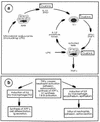The Pseudomonas aeruginosa quorum-sensing signal molecule N-(3-oxododecanoyl)-L-homoserine lactone has immunomodulatory activity
- PMID: 9423836
- PMCID: PMC107855
- DOI: 10.1128/IAI.66.1.36-42.1998
The Pseudomonas aeruginosa quorum-sensing signal molecule N-(3-oxododecanoyl)-L-homoserine lactone has immunomodulatory activity
Abstract
Diverse gram-negative bacterial cells communicate with each other by using diffusible N-acyl homoserine lactone (AHL) signal molecules to coordinate gene expression with cell population density. Accumulation of AHLs above a threshold concentration renders the population "quorate," and the appropriate target gene is activated. In pathogenic bacteria, such as Pseudomonas aeruginosa, AHL-mediated quorum sensing is involved in the regulation of multiple virulence determinants. We therefore sought to determine whether the immune system is capable of responding to these bacterial signal molecules. Consequently the immunomodulatory properties of the AHLs N-(3-oxododecanoyl)-L-homoserine lactone (OdDHL) and N-(3-oxohexanoyl)-L-homoserine lactone (OHHL) were evaluated in murine and human leukocyte immunoassays in vitro. OdDHL, but not OHHL, inhibited lymphocyte proliferation and tumor necrosis factor alpha production by lipopolysaccharide-stimulated macrophages. Furthermore, OdDHL simultaneously and potently down-regulated the production of IL-12, a Th-1-supportive cytokine. At high concentrations (>7 x 10(-5) M) OdDHL inhibited antibody production by keyhole limpet hemocyanin-stimulated spleen cells, but at lower concentrations (<7 x 10(-5) M), antibody production was stimulated, apparently by increasing the proportion of the immunoglobulin G1 (IgG1) isotype. OdDHL also promoted IgE production by interleukin-4-stimulated human peripheral blood mononuclear cells. These data indicate that OdDHL may influence the Th-1-Th-2 balance in the infected host and suggest that, in addition to regulating the expression of virulence determinants, OdDHL may contribute to the pathogenesis of P. aeruginosa infections by functioning as a virulence determinant per se.
Figures







References
-
- Bainbridge T, Fick R D. Functional importance of cystic fibrosis immunoglobulin fragments generated by Pseudomonas aeruginosa elastase. J Lab Clin Med. 1989;114:728–733. - PubMed
-
- Bainton N J, Bycroft B W, Chhabra S R, Stead P, Gledhill L, Hill L P J, Rees C E D, Winson M K, Salmond G P C, Stewart G S A B, Williams P. A general role for the lux autoinducer in bacterial cell signalling: control of antibiotic biosynthesis in Erwinia. Gene. 1992;116:87–91. - PubMed
-
- Cheng H C, Nishio H, Hatase O, Ralph S, Wang J H. A synthetic peptide derived from p34 cdc 2 is a specific and efficient substrate of src-family tyrosine kinases. J Biol Chem. 1992;267:9248–9256. - PubMed
-
- Chhabra S R, Stead P, Bainton N J, Salmond G P C, Stewart G S A B, Williams P, Bycroft B W. Autoregulation of carbapenem biosynthesis in Erwinia carotovora ATCC 39048 by analogues of N-(3-oxohexanoyl)-l-homoserine lactone. J Antibiot. 1993;46:441–454. - PubMed
Publication types
MeSH terms
Substances
LinkOut - more resources
Full Text Sources
Other Literature Sources

